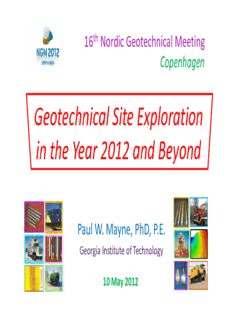
Friction Angle PDF
Preview Friction Angle
16th Nordic Geotechnical Meeting Copenhagen Geotechnical Site Exploration in the Year 2012 and Beyond Paul W. Mayne, PhD, P.E. Georgia Institute of Technology 10 May 2012 Purposes: Geotechnical Site Investigation A must prior to all geotechnical projects Determine geostratigraphy for site development Information for construction and foundation selection Collect geotechnical data for parameter evaluation Input to analytical models and numerical FEM Minimize surprises during construction Mitigate potential for legal involvement Geotechnical Site Characterization in 2012 State‐of‐the‐Art (SOA) = What we CAN do State‐of‐the‐Practice (SOP) = what we ARE doing Brief remarks on International Geotechnical Experimentation Sites (IGES) Geotech Education: overemphasis on lab Best Practices:.... small projects.... vs. medium ..... vs. large‐projects This talk = short SOA to improve current SOP Mayne ≠ SOB Initial Conditions INDICES STATE Geologic Origin Void Ratio, e 0 Age, A Z Unit Weight, G w T Grain Sizes, D Relative Density, D 50 R Mineralogy Z State Parameter, Plasticity, PI Vertical Stress, vo Shape (fractals) Hydrostatic Pressure, u o Sphericity, S Soil Yield Stress Ratio, YSR ph Element A Roundness, R Saturation, S (%) n Angularity, A Geostatic K = ’/ ’ ng 0 ho vo Packing limits: e and e Stiffness, G = G max min 0 max Specific Surface, S S State Parameter, ψ Particle characteristics for DEM Degree of cementation (crushing strength, modulus, Fabric and void index, I vo roughness, friction) Continuity (intact or fissured) Geotechnical Parameters CONDUCTIVITY STIFFNESS Stiffness: G = G Hydraulic: k , k 0 max v h Shear Modulus, G' and G Thermal: k u e Electrical: Elastic Modulus, E' and E u Chemical: D Bulk Modulus, K’ f Transmissivity, T Constrained Modulus, D’ m Permittivity, P Tensile Stiffness, K m T Poisson’s Ratio, COMPRESSIBILITY Effects of Anisotropy (G /G ) Recompression index, C vh hh r Nonlinearity (G/G vs ) Yield Stress, ' (and YSR) max s y Subgrade Modulus, k Preconsolidation, ’ (and OCR) s p Spring Constants, k , k , k , k Coefficient of Consolidation, c z x θ v Virgin Compression index, C STRENGTH c Swelling index, C Drained and Undrained, s max Peak (s , c’, ’) RHEOLOGICAL u Post‐peak, ' Strain rate, t Remolded strength Time since consolidation (T) Softened or critical state, s Coef. secondary compression, C u (rem) Residual (c ’, ’) Creep rate, r r R Cyclic Behavior ( / ') Time to failure, t cyc vo f “...when you can measure what you are speaking about and express it in numbers, you know something about it; but when you cannot express it in numbers, your knowledge is of a meager and unsatisfactory kind" Lord Kelvin (1883) Jaksa (2005) US National Geotechnical Experimentation Sites (NGES) Established in USA jointly by: National Science Foundation (NSF) Federal Highway Administration (FHWA) ASCE Geo‐Institute 6 NGES in continental USA ASCE Geotechnical Special Publication (GSP) No. 93 (2000) NGES: Texas A&M Sand Site US National Geotechnical Test Site (Briaud & Gibbens, 1999; Briaud, 2007) SPT‐N value, N (bpf) Tip Resistance, q (MPa) Limit Pressure, P (kPa) DMT Pressures (bars) Velocity, V (m/s) 60 t L s 0 10 20 30 40 50 60 70 0 10 20 0 500 1000 1500 0 10 20 30 40 50 0 100 200 300 400 0 Upper Pleistocene Clean CHT 1 Sands (SP) DMT 2 3 4 ) silty Sands (SP‐SM) ers 5 CPT t e m h ( 6 t p e D Silty to Clayey 7 Sands (SC ‐ SM) SPT 8 9 PMT 10 p0 Hard Eocene Clay p1 Shale 11 Crosshole 2‐1 12 NGES: Opelika, Alabama Piedmont residual fine sandy silts (Vinson and Brown, 1997; Mayne & Brown, 2003)
Description: